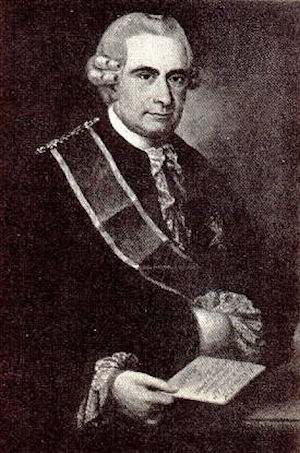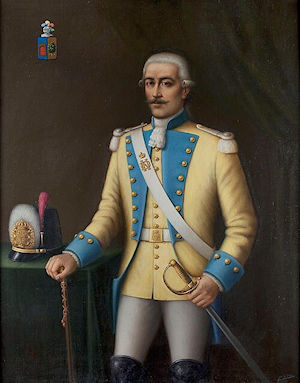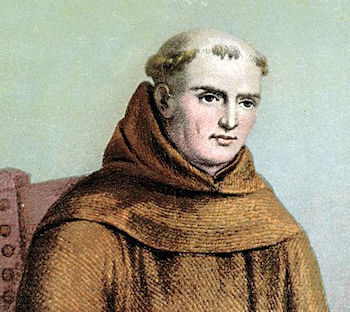 |  |
By Greg Niemann

While Captain Gaspar de Portolá and Franciscan Padre Junipero Serra are well known for establishing the first Spanish settlements and missions in Alta (U.S.) California, it was José de Gálvez y Gallardo, the king’s Inspector General in Mexico, who was instrumental in directing their colonizing efforts.
Padre Serra (now Saint Junipero Serra) is revered in California for establishing the first nine of the U.S. state’s eventual 21 missions. Serra had founded the only Franciscan mission in Baja California (San Fernando Velicatá, 1769), and only months later established Alta California’s first mission in San Diego, beginning Serra’s Alta California legacy.
Not so well-known is the backstory - behind the Spanish decisions to plot his endeavors.
The Jesuit Order of Catholic clergy had already established settlements for Spain in Baja California, a total of 15 missions from San Jose Del Cabo in the south to Santa Maria in the north.
The Jesuits had enjoyed power and authority and were the leaders, even paying the soldiers who accompanied them for protection. Their success, however, did not please everyone, and resentment and jealousies were rampant. Rumors reached the king citing the Jesuits’ alleged accumulated wealth and power.
To show who’s boss, Spain’s King Charles III, on Jan. 29, 1767, abruptly ordered the Jesuit Order expelled from the New World. Thus, 16 Jesuits departed Baja California after seven decades of difficult efforts establishing a physical as well as spiritual foothold on the peninsula.
Meanwhile, Serra was in charge of the Franciscans Order’s missionary work in northwestern mainland Mexico. Hastily ordered to Baja California to take over, Serra and 15 Franciscan padres landed at Loreto on Apr. 1, 1768.
By this time Spain was considering settlements in Alta California as they realized Russian fur trappers and explorers were working their way down the northwest Pacific Coast and were launching outposts almost to San Francisco. Spain had to challenge their intrusion!

An Ambitious Politician
Key to this decision were the reports from the ambitious Spanish politician, José de Gálvez. He had earlier got the king’s ear by spreading rumors about British and Dutch supposed plans to add California to their own empires.
Galvez had been sent to New Spain (Mexico) in 1765 as Inspector General, where he held more power than the Viceroy. He exercised almost unlimited powers to examine and reform administration, tribunals of justice, and collection of revenues.
He hated the Jesuits and was instrumental in getting them removed. Also, he had coveted establishing a presidio at Monterey, and wrote a series of reports stressing the feasibility and desirability of Spain occupying Monterey.
He was also quick to pass on reports about possible Russian intrusion. When the Spanish ambassador in Russia confirmed the tsar was about to establish settlements farther down the California coast towards Monterey, Gálvez exposed that Russian threat for all it was worth.
Thus persuaded, King Charles III gave Gálvez broad powers and also royal orders to organize an expedition to head north and colonize Alta California, upsetting any possible Russian advance.
Gálvez had been a Spanish lawyer who, in 1762, had secured a position as attorney to Prince Carlos, the future king (Carlos IV), and in 1765 had received his appointment to New Spain where he established a naval base in San Blas (Nayarit).
On Jul. 12, 1768, Gálvez arrived in Loreto to plan the expedition to Alta California and outfit soldiers and missionaries for the task. It would be in five units, two by land and three by sea.
For the sea journey, he had already secured the largest and strongest brigantines in western Mexico, the San Carlos, San Antonio, and the San Jose. The San Jose disappeared at sea and the other two were delayed arriving in San Diego. The San Carlos, however, became the first ship to enter San Francisco Bay.

Gaspar de Portolá to command expedition
The land expeditions would both be under the command of the Governor of Baja California, Captain Gaspar de Portolá, a soldier of noble birth who had fought well for Spain in Europe.
Gálvez issued him strict instructions, including:
“To prevent difficulties and disaster in the outcome, the most prudent supervision must be exercised. Therefore, I charge you with zeal and vigilance to maintain the most exact discipline over the soldiers of the expedition... The soldiers are to be punished as in the case of an irremissible crime... that could also bring disaster to the entire expedition.”
The advance party was to be led by Captain Fernando Javier de Rivera y Moncada, then commander of the Loreto Presidio.
Ordered by Gálvez, Rivera y Moncada stopped at each Baja mission on his way north and rounded up as many supplies as possible in the way of cattle, horses and other provisions. Thus, the missions were duly stripped as the advance party made its way north, many never fully recovered from such ransacking.
Gálvez chose Serra to head the missionary team for the California expedition - allegedly without bothering to ask if he was agreeable to this. As it turned out however, Serra was more than willing to go along.
The incoming Franciscan padres quickly learned that, largely because of Gálvez’ influence, they did not experience the theocratic authority that the Jesuits had enjoyed for 70 years.
Instead of the religious leaders calling the shots, it was Gálvez who directed what the Franciscans would do. He informed Serra that the padres accompanying the troops would initially establish missions at San Diego, Monterey and one place in between, with others to follow.
He wanted to use Baja’s then northernmost Jesuit mission, Santa Maria, as a place to supply the future missions to the north. As Mission Santa Maria had insufficient pastureland for the incoming livestock, Rivera y Moncada was forced to relocate to a place called Velicatá.

For the missionaries, Serra selected Padre Juan Crespi to join the advance party, while he himself would make the journey with Gaspar de Portolá and the main party.
On Mar. 25, 1769 the advance party with Rivera y Moncada, Padre Crespi, 25 soldiers, a guide, three mule drivers and a large number of Indians armed with bows and arrows left the Velicatá valley and arrived in San Diego on May 14, 1769, 50 days later.
His foot plagued him
Serra, then 56 years old, born on the Spanish island of Mallorca, was a small and sickly child who entered the seminary at age 16. He overcame his illnesses but as an adult was still only 5’2” or 3.”
After initially arriving in Mexico, he made the 270 mile walk from Veracruz to Mexico City during the rainy season and his foot began to swell from fatigue and mosquito bites. The foot plagued him the rest of his life.
When the main land party arrived at Velicatá on May 13, 1769, Padre Serra founded the Mission San Fernando, and Captain Portolá established a presidio in order to facilitate later communication with Alta California.
By then, Serra’s foot and leg infections had become almost crippling. Portolá tried to persuade him not to join the expedition, but Serra stood fast.
Undeterred, Serra and Portolá continued north to fulfill Gálvez’ order and establish the presidios and missions of Alta California. Serra’s leg began to worsen.
When Portolá suggested they construct a litter to have him carried by Indians, Serra took the matter into his own hands. He approached the muleteer who healed the sores of animals and begged him to treat his leg as he would an animal. The muleteer balked but finally mixed the tallow and herbs and applied it to the wounds.
The poultice worked well enough for Serra to continue the journey but it did not alleviate the pain endured by him the rest of his life.
Finally, on Jul. 16, 1769, after the main party arrived in San Diego, Serra established the Mission San Diego de Alcala.
The beginnings of California
The expedition leader Captain Gaspar de Portolá became a legend in the annals of California history, but no less than Junipero Serra did.
Serra went on to establish nine U.S. missions, finally passing away at his favorite one, San Carlos de Carmelo (Carmel), at the age of 71 where he is buried. The Catholic Church nominated Serra for sainthood and he was beatified in 1988 by Pope John Paul II and canonized into sainthood in 2015 by Pope Francis, becoming California’s Patron Saint.
Captain Gaspar de Portolá, who served as the first governor of the Californias (1767 to 1770), was later appointed governor of Puebla before he returned to Spain where he died in 1786. Throughout California there are numerous geographical locations, including towns, streets and schools, named for him. As for Gálvez, according to Mexican historian Pablo L. Martinez, “Except for the conquest of Upper California, everything else he (Gálvez) did was a complete failure.” Martinez cited his dismantling of much of the Jesuits’ efforts, issuing useless decrees, destroying private initiative by taking over mines, and much more.
Two other historians, James Rawls and Walton Bean, attributed Spain's expansion into Alta California to Galvez’ intense personal ambitions. “...Although he was a brilliant, forceful, and generally successful administrator,” they wrote, “he was also unusually vain, selfish, ruthless, deceitful and unstable. It was, indeed, because of Gálvez's possession of this very combination of qualities that the occupation of San Diego and Monterey, long considered and periodically given up as hopeless, actually materialized.”
Jose de Gálvez later played an important role in Spain’s negotiations with Portugal and was rewarded with the title of Marquis of Sonora. He became patriarch of the important political clan that included his brother Matías de Gálvez and nephew Bernardo de Gálvez. He also worked on the reorganization of Spanish territories in America before he died in 1787 in Spain.
And the Russians never did get south of San Francisco.

This was another trip for me to Baja. It was better than ever. I was really trusting Baja Bound...

Have been working with Shawna Hill for several years and found her to be very customer focused. ...

One of the best Insurance experiences I've had. One, the prices are very very fair, especially...